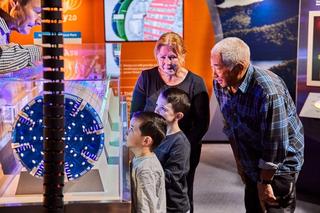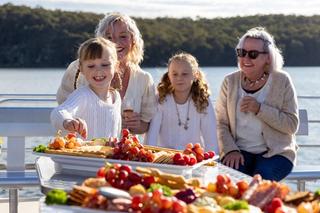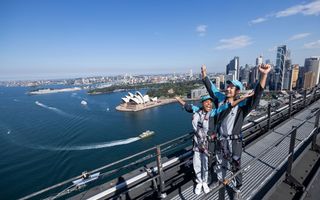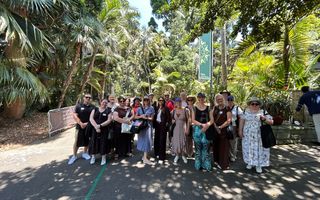New research shows 'skip-gen', multi-generational and 'kidfluence' holidays are redefining travel in Australia.
Hilton’s 2026 Trends Report shows that grandparents and grandchildren are hitting the road together—and often without parents. In Australia, 51 per cent of respondents reported having taken—or planning to take—a skip-gen holiday. Across the region, the trend is strongest in China (86 per cent) and India (79 per cent).
A third of Australian families (33 per cent) are also taking holidays with three or more generations at least once a year, as they increasingly focus on fostering togetherness, creating lasting memories and strengthening bonds.
According to Hilton’s global research, respondents’ number one motivation to travel for leisure in 2026 is to rest and recharge (56 per cent). However, 59 per cent of Australian travellers said spending time with family outweighs personal relaxation as their top holiday priority.

When it comes to activities, culinary exploration (72 per cent) and visits to historical and cultural landmarks (69 per cent) lead the way for Australians, reflecting families’ desire for stays that inspire discovery, learning and meaningful connection.
Australia’s rich and diverse food culture plays a big part in this trend, and it also attracts international visitors seeking food-led experiences—particularly families from nearby markets such as Singapore, where culinary adventures are a top travel priority.

More than half (57 per cent) of families in Australia prefer interconnecting rooms or family suites, while 42 per cent prioritise kids’ activities on-site. Relaxation and wellness activities (38 per cent) are also important, underscoring the need for stays that cater to every generation.
The rise of “kidfluence” travel
A new study has confirmed multigenerational travel is also booming among American travellers, often led by "kidfluence", with children playing an active role in choosing destinations.
The 2025 U.S. Family Travel Survey by The Family Travel Association, Good Housekeeping and the NYU School of Professional Studies (NYU SPS) Jonathan M. Tisch Center of Hospitality found most Americans (92 per cent) say they plan to travel with their children or grandchildren in the next year—the highest intent level since the pandemic.
Today, children have computers in their pockets, providing access to information about destinations and experiences around the world through the internet, social media and streaming platforms.
The result is that younger family members—particularly those ages 7-18—have strong opinions about where their family goes on holiday.
“The planning experience is evolving rapidly, driven by the next generation's input and the digital tools available," said Anna Abelson, adjunct instructor at the NYU SPS Jonathan M. Tisch Center of Hospitality and co-author of the survey.
"Our survey confirms an important shift in family dynamics toward 'kidfluence', with children now serving as true 'co-pilots' in trip planning.”
The significance of kidfluence could also impact the types of trips families choose, as the survey lists beach holidays, theme parks and water parks among the top family travel destinations.
Australian Bureau of Statistics data shows United States was the third-largest source market for visitors to NSW in August 2025, behind China and New Zealand. There were 27,170 American visitors during the month, compared to 25,660 in August 2019.
International markets key to visitor economy growth
The NSW Visitor Economy Strategy has clear targets to generate $91 billion in annual visitor expenditure, 40,000 new hotel rooms, 8.5 million new airline seats and an additional 150,000 jobs by 2035.
The continued recovery of international travel presents a major growth opportunity. The NSW Government is seeking to realise the full potential of existing strongly performing markets and lean into markets where there is great growth potential.
When compared to domestic visitor spending, international market spending is expected to grow at a faster pace, contributing $24 billion – 26 per cent of total visitor expenditure – by 2035.
China, the United States, the United Kingdom and South Korea have been highlighted as "star performing" markets.
The NSW Visitor Economy Strategy 2035 focuses on five key pillars to accelerate growth:
- Make it Easy for More People to Visit – growing aviation capacity by 8.5 million seats, unlocking 40,000+ new accommodation rooms and expanding the tourism workforce.
- Focus on Attracting Visitors – elevating the NSW and Sydney brands through bold storytelling and data-led marketing, showcasing Sydney as a destination beyond well-known postcards.
- Drive Growth through Events – locking in a nation-leading calendar of major sport, culture and business events to draw visitors year-round.
- Focus on Experiences – delivering immersive, high-quality and culturally rich visitor offerings across metro and regional NSW that highlight our stunning landscapes and world-leading produce.
- Leverage Data and Insights – improving access to real-time data and consumer insights to enable agile decision-making across the sector.
Learn more here.



